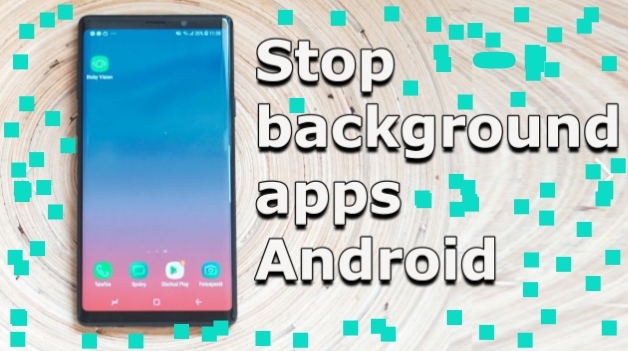Is your Android phone draining battery too fast, heating up for no reason, or slowing down during everyday use? Background apps are often the hidden culprit.
These apps keep running even after you’ve closed them, silently consuming memory, power, and data.
This comprehensive guide shows you how to stop apps from running in the background on Android, using built-in settings, advanced tools, and app-specific controls—no root required.
Whether you’re trying to conserve battery, boost performance, or stop sneaky apps from hogging resources, you’ll find a method here that works.
What Are Background Apps and Why Do They Matter?
Definition
Background apps are those that continue to perform operations even when you’re not actively using them. They may:
- Sync emails and data
- Show push notifications
- Track your location
- Use mobile or Wi-Fi data
Common Examples
- Social media apps (Facebook, Instagram)
- Email clients (Gmail, Outlook)
- Messaging apps (WhatsApp, Telegram)
- News and weather apps
Why They Matter
- Battery drain: Continuous syncing burns power
- Memory (RAM) use: Slows down multitasking
- Data usage: Apps may download content or ads in background
- Privacy: Some apps track activity without your knowledge
Method 1: Restrict Background Activity in Settings
Steps:
- Open Settings > Apps
- Tap See all apps
- Select the app you want to restrict
- Tap Battery
- Choose Restricted or Don’t allow background activity
When to Use
- Apps that don’t need constant updates (games, offline apps)
- If your phone feels slow or hot
This tells Android to prevent the app from running when not in use.
Method 2: Use Adaptive Battery (Android 9+)
Adaptive Battery uses AI to limit battery usage for apps you rarely use.
Steps:
- Go to Settings > Battery > Adaptive Preferences
- Enable Adaptive Battery
Bonus Tip:
- Tap Battery > Usage to see which apps are draining power most
Method 3: Use Developer Options to Limit Background Processes
This advanced method limits how many background apps Android can keep alive at once.
Steps:
- Enable Developer Options:
- Go to Settings > About Phone
- Tap Build number 7 times
- Enter PIN to confirm
- Go to Settings > System > Developer Options
- Scroll to Background process limit
- Set to:
- No background processes
- At most 1-4 processes
Warning: This affects system stability. Don’t use unless necessary.
Method 4: Disable or Uninstall Problematic Apps
Some pre-installed apps (bloatware) constantly run in the background.
Steps:
- Go to Settings > Apps > See all apps
- Tap the app > Disable (if available)
- If not system app: Tap Uninstall
Disabling is safer than uninstalling for system apps.
Method 5: Manage Background Data Usage
Even if apps aren’t running constantly, they may still use data in the background.
Steps:
- Go to Settings > Apps > [App Name] > Mobile data & Wi-Fi
- Toggle off Background data
Good For:
- Limiting data charges
- Preventing apps from syncing unless open
Method 6: Use Battery Saver Mode
This system-wide setting forces apps to pause background activity.
Steps:
- Go to Settings > Battery > Battery Saver
- Enable it manually or schedule based on time/percentage
Battery Saver mode will restrict background activity for all non-essential apps.
Method 7: App-Specific Restrictions
Many Android skins (Samsung One UI, MIUI, OxygenOS) offer additional app control.
Samsung:
- Settings > Device care > Battery > App power management
- Add apps to Sleeping apps or Deep sleeping apps
Xiaomi:
- Settings > Battery & Performance > App Battery Saver
- Choose apps and set to Restrict background activity
OnePlus:
- Settings > Battery > Battery optimization
- Set unused apps to Optimized
Method 8: Use Third-Party Tools (Cautiously)
Apps:
- Greenify (root optional)
- Brevent (non-root, advanced)
- Naptime (requires root)
These apps can aggressively hibernate or kill background processes, but may break notifications or cause other issues. Use only if system options fail.
Method 9: Reboot Regularly
Restarting your device clears temporary background tasks and RAM-heavy apps.
Best Practice:
- Reboot at least once a week
- Avoid letting your phone stay on for weeks without a restart
Preventive Practices
1. Avoid Auto-Start Apps
Some apps auto-run on boot. Check Settings > Apps > Auto-start if available.
2. Monitor Battery Stats
Use built-in battery usage tools to catch battery hogs early.
3. Install Lite Versions of Apps
Facebook Lite, Messenger Lite, and similar apps are less resource-intensive.
FAQs
Q: Is it safe to stop background apps?
A: Yes, as long as you’re not disabling system-critical apps.
Q: Will I miss notifications?
A: Possibly. Apps like WhatsApp may delay messages if restricted too much.
Q: Can I stop all background apps at once?
A: Not without root. You can enable Battery Saver or use developer limits as a workaround.
Final Thoughts
Background apps are a silent drain on Android devices, affecting performance, battery, and data. Fortunately, you don’t need to root your phone or install sketchy apps to take control.
With the methods outlined here—from system settings to advanced battery management—you can strike a balance between convenience and control. Restrict what you don’t need, monitor the rest, and enjoy a faster, longer-lasting phone.
Looking to save even more battery? Next up, we’ll show you how to optimize Android screen brightness and animation settings for maximum endurance.














